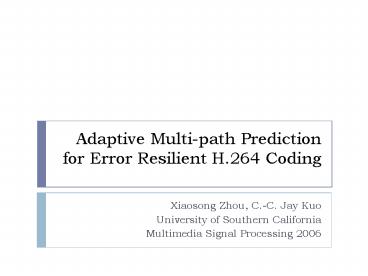Adaptive Multi-path Prediction for Error Resilient H.264 Coding - PowerPoint PPT Presentation
1 / 24
Title:
Adaptive Multi-path Prediction for Error Resilient H.264 Coding
Description:
... consider de-blocking operation which attenuate the error generated by error concealment ... an-1 : attenuation factor of the propagating error from n-1st to ... – PowerPoint PPT presentation
Number of Views:33
Avg rating:3.0/5.0
Title: Adaptive Multi-path Prediction for Error Resilient H.264 Coding
1
Adaptive Multi-path Prediction for Error
Resilient H.264 Coding
- Xiaosong Zhou, C.-C. Jay Kuo
- University of Southern California
- Multimedia Signal Processing 2006
2
Outline
- Introduction
- Adaptive Multi-path Prediction for H.264
- Observation and Research Motivation
- Computation of Expected Decoder Distortion
- Adaptive Reference Selection (ARS) Scheme
- Experimental Results
- Conclusion and Future Work
3
Introduction
- Video communication problem
4
Introduction
- Error Resilient tools
- Error Resilient Entropy Coding (EREC)
- Unequal Error Protection by Layered Coding
- Mismatch exists, error propagation cant be
stopped properly - Not compatible with H.264
5
Introduction
- One way for reducing error propagation
- Intra Refreshing insert intra macroblocks in
temporally coded (P or B) video frames - Intra macroblocks in H.264 are coded by intra
prediction based on neighbors - Intra macroblock have much lower coding
efficiency than inter macroblocks - Not suitable for H.264
6
Introduction
- Multiple reference (long-term reference) motion
compensation predictive coding (LTMCP) - Enhance coding efficiency
- Proposed for error resilience
- T. Wiegand et. al, Error-resilient video
transmission using long-term memory
motion-compensated prediction - Select the best reference frame by evaluating the
expected reconstruction calculated based on the
error feedback and an error propagation model
7
Observation and Research Motivation
- Sequential prediction
- In H.264, LTMCP allows encoder to choose the best
prediction from a number of reference frames - The best reference of some blocks may exist in a
long-term reference frame - But, sequential prediction is still common in
H.264
8
Observation and Research Motivation
- Utilize long term reference frames for error
resilience - Error resilience performance is improved using
alternative prediction patterns
Different predictive patterns
9
Observation and Research Motivation
- If a video stream is encoded into these fixed
prediction patterns - As most video frames are forced to use a distant
reference frame, coding efficiency is likely to
be sacrificed - Performance vary for different macroblocks since
its largely dependent on video content - Its difficult to design a fixed prediction
pattern at the frame level - In H.264, reference frame selection is done at
macroblock level - Incorporate the idea of multi-path predictive
coding at the macrokblock level
10
Computation of Expected Decoder Distortion
- Error map
- Created and maintained for each allowed reference
frame in buffer - Store the absolute value of the expected error e
of every pixel in the frame
11
Computation of Expected Decoder Distortion
- can not be obtained directed
- For a pixel in the nth frame, update its value of
e by - pe channel error rate
- ep,n expected error from error propagation
- ec,n expected error from error concealment when
pixel is lost
12
Computation of Expected Decoder Distortion
- To calculate ec,n, the mismatch caused by
reconstruction of error concealment scheme - Consider a simple error concealment method
- Intra block copy pixel from the boundary of
correctly reconstructed block above the target
block - Inter block copy the block from the same
position in the previous frame - Should also consider de-blocking operation which
attenuate the error generated by error
concealment - d
- en-1 error value of the pixel where MV points
in reference frame - an-1 attenuation factor of the propagating
error from n-1st to nth frame - Expected decoder distortion
13
Adaptive Reference Selection (ARS)
- in LTMCP, multiple predictions can be created to
encode block M - The predictions generated from multi-reference
frames are evaluated based on both coding and
error resilience performance
14
Adaptive Reference Selection (ARS)
- Three used vectors
- xN (X1, , XN) the set of all N MBs in a GOP
- mN (M1, , MN) all modes selected by each MB
- qN (Q1, , QN) quantization parameters used
to encode these MBs - The overall mode decision problem is
15
Adaptive Reference Selection (ARS)
- Convert to an unconstraint optimization problem
using Lagrange Multiplier method
16
Adaptive Reference Selection (ARS)
- Overall expected distortion through erroneous
channel - expected error that has mean zero
- decoder error and uncorrelated to
- Therefore
17
Adaptive Reference Selection (ARS)
- Rewrite mode decision problem equation
- Assumption rate and
distortion of MB i have no
impact to other MBs - expected overall distortion
of the GOP due to error propagation
18
Adaptive Reference Selection (ARS)
- d
- a attenuation factor
- M expected number of frames in the future
prediction path of the pixel - The method to calculate M
19
Experimental Results
20
Experimental Results
21
Experimental Results
- Averaged Frame Index
22
Experimental Results
- R-D performance comparison under test condition T2
23
Experimental Results
- R-D performance comparison under test condition T7
24
Conclusion and Future Work
- An adaptive prediction selection scheme was
proposed in this work to create multiple
prediction paths in the compressed video stream - The proposed scheme is able to maintain good
coding efficiency of the compressed stream while
serve as an effective error resilience tool in
visual communication applications - In the future, we plan to develop a new model to
simplify the calculation of the expected decoder
distortion to reduce the complexity of the
proposed scheme































